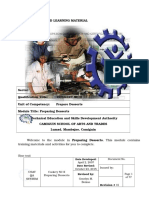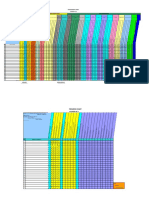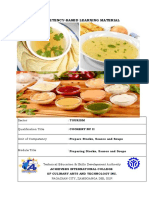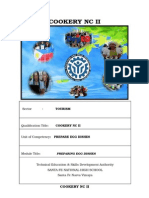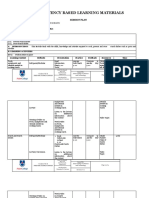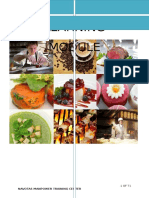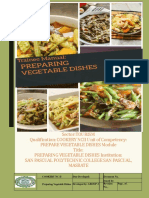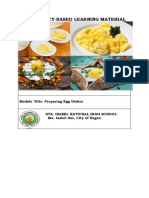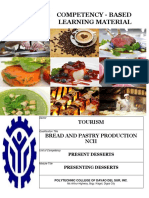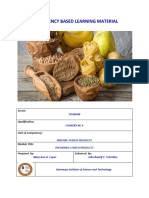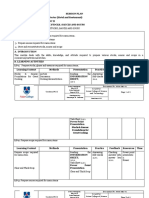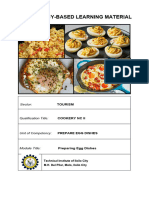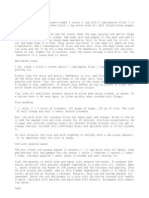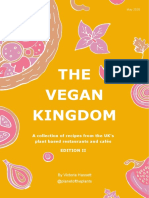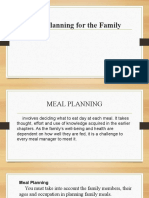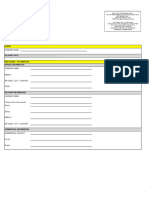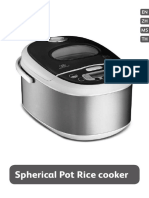Uc 12 Preparing Desserts
Uc 12 Preparing Desserts
Uploaded by
Kiven OlivarCopyright:
Uc 12 Preparing Desserts
Uc 12 Preparing Desserts
Uploaded by
Kiven OlivarCopyright
Share this document
Did you find this document useful?
Is this content inappropriate?
Copyright:
Uc 12 Preparing Desserts
Uc 12 Preparing Desserts
Uploaded by
Kiven OlivarCopyright:
COMPETENCY BASED LEARNING MATERIAL
Sector Tourism Sector (Hotel and Restaurant)
Qualification Title: Cookery NCII
Unit of Prepare Desserts
Competency:
Module Title: Preparing Desserts
Technical Education and Skills Development Authority
University of Mindanao
Matina Campus, Davao City
Document No.: CBLM-COOKERY-NC
Date Developed:
II-CORE-8-2020
COOKERY NC II March 2020
UC 12 Issued by:
Prepare Desserts Developed by: University of
Kiven G. Olivar Mindanao Page 1 of 81
Revision # 00
HOW TO USE THIS COMPETENCY BASED LEARNING MATERIAL
The unit of competency, “Prepare Desserts”, is one of the
competencies of COOKERY NCII, a course which comprises the knowledge,
skills, and attitudes required for a TVET trainee to possess.
The module, “Preparing Desserts”, contains training and activities
related to the preparation, presentation and storing various egg dishes.
In this module, you are required to go through a series of learning
activities in order to complete each learning outcome. In each learning
outcome are Information Sheets, Self-checks, Operation Sheets, Task Sheets,
and Job Sheets. Follow and perform the activities on your own. If you have
questions do not hesitate to ask questions and assistance from your
facilitator.
Remember to:
Read information sheet and complete the self-checks
Perform the Task Sheets, Operation Sheets, and Job Sheets until you are
confident that your output conforms to the Performance Criteria Checklist
that follow the said worksheets.
Submit outputs of the Task Sheets, Operation Sheets and Job Sheets to
your facilitator for evaluation and recording in the Achievement Chart.
Outputs shall serve as your portfolio during the Institutional Competency
Evaluation. When you feel confident that you have had sufficient practice,
ask your trainer to evaluate you. The results of your assessment will be
recorded in your Achievement Chart and Progress Chart.
You must pass the Institutional Competency Evaluation for this
competency before moving to another competency. A Certificate of
Achievement will be awarded to you after passing the evaluation.
You need to complete this module before you can perform the module
on Package Prepare Food.
COOKERY NC II
Document No.: CBLM-COOKERY-NC
Date Developed:
II-CORE-8-2020
COOKERY NC II March 2020
UC 12 Issued by:
Prepare Desserts Developed by: University of
Kiven G. Olivar Mindanao Page 2 of 81
Revision # 00
COMPETENCY BASED LEARNING MATERIAL
LIST OF COMPETENCIES
NO. Unit of Competency Module Title Code
1. Clean and Maintain Cleaning and TRS512328
Kitchen Premises Maintaining
Kitchen Premises
2. Prepare Stocks, Sauces Preparing Stocks, TRS512331
and Soups Sauces and
Soups
3. Prepare Appetizers Preparing TRS512329
Appetizers
4. Prepare Salads and Preparing Salads TRS512329
Dressings and Dressings
5. Prepare Sandwiches Preparing TRS512330
Sandwiches
6. Prepare Meat Dishes Preparing Meat TRS512338
Dishes
7. Prepare Vegetables Dishes Preparing TRS512332
Vegetables
Dishes
8. Prepare Egg Dishes Preparing Egg TRS512332
Dishes
9. Prepare Starch Dishes Preparing Starch TRS512332
Dishes
10. Prepare Poultry and Game Preparing Poultry TRS512333
Dishes and Game Dishes
11. Prepare Seafood Dishes Preparing TRS512334
Seafood Dishes
12. Prepare Dessert Preparing TRS512335
Dessert
13. Package Prepared Food Packaging TRS512340
Prepared Food
MODULE CONTENT
UNIT OF COMPETENCY : Prepare Desserts
MODULE TITLE : Preparing Desserts
Document No.: CBLM-COOKERY-NC
Date Developed:
II-CORE-8-2020
COOKERY NC II March 2020
UC 12 Issued by:
Prepare Desserts Developed by: University of
Kiven G. Olivar Mindanao Page 3 of 81
Revision # 00
MODULE DESCRIPTOR :
This module deals with the skills and knowledge and attitude in the
Preparation of a range of hot, cold and frozen desserts in a commercial
kitchen or catering operation.
Nominal Duration : 24 hours
At the end of this module, you MUST be able to:
LO1. Perform Mise en place.
LO2. Prepare Desserts and prepare Sweet Sauces.
LO3. Plate/Present Desserts.
LO4. Store Desserts
COMPETENCY SUMMARY
Qualification Title : Cookery NC II
Document No.: CBLM-COOKERY-NC
Date Developed:
II-CORE-8-2020
COOKERY NC II March 2020
UC 12 Issued by:
Prepare Desserts Developed by: University of
Kiven G. Olivar Mindanao Page 4 of 81
Revision # 00
Unit of Competency : Prepare Desserts
Module Title : Preparing Desserts
Introduction
This module deals with the skills and knowledge and attitude in the
Preparation of a range of hot, cold and frozen desserts in a commercial
kitchen or catering operation.
Learning Outcomes:
Upon completion of this module, you MUST be able to:
LO1: Perform Mis en place
LO2: Prepare Desserts and prepare Sweet Sauces.
LO3: Plate/Present Desserts
LO4: Store Desserts
LEARNING OUTCOME #1
PERFORM MISE EN PLACE
ASSESMENT CRITERIA:
Document No.: CBLM-COOKERY-NC
Date Developed:
II-CORE-8-2020
COOKERY NC II March 2020
UC 12 Issued by:
Prepare Desserts Developed by: University of
Kiven G. Olivar Mindanao Page 5 of 81
Revision # 00
1. Tools, utensils and equipment are cleaned, sanitized and prepared based on
the required tasks.
2. Ingredients are identified correctly, according to standard recipes, recipe
cards or enterprise requirements.
3. Ingredients are assembled according to correct quantity, type and quality
required.
4. Ingredients are prepared based on the required form and time frame.
5. Ingredients are selected, measured and weighed according to recipe
requirements
6. Appropriate equipment is selected and used in accordance with
manufacturers manual
7. Frozen ingredients are thawed following enterprise procedure
8. Where necessary, raw ingredients are washed with clean potable water.
CONTENTS:
1. Different types of Desserts and sweets
2. Details and Characteristics of Desserts and Sweets
3. Varieties and suitable ingredients for Desserts and Sweets
4. Nutritional Value of Desserts
5. Principle and Practices of Hygiene on Handling ang Storage of Dairy
Products
CONDITIONS: The students/ trainees must be provided with the following
EQUIPMENT TOOLS AND SUPPLIES AND MATERIALS
ACCESSORIES
LCD Equipment for Desserts and Sweet Sauces May
Projector making desserts sweets include:
(Optional and sweets Puddings
for lecture). Blender , pies, Sugar syrups
Overhead Ice cream tarts, Fruit syrups
Projector machines flans, fruit purees,
(Optional Ice maker fitters sauces and
for lecture). Juicers and Custard, coulis
Television vitaminizes creams chocolate-
and Mixer Prepared based sauces
multimedia fruit
Oven sabayon and
player Charlotte
Chiller and zabaglione
Whiteboard ,
Freezer custard and
Applicable bavarois,
Steamer cremes
equipment mousse,
Weighing flavored
as souffle
scales butters and
prescribed Sabayon
Low creams
by Training Meringue
pressure sabayon and
Document No.: CBLM-COOKERY-NC
Date Developed:
II-CORE-8-2020
COOKERY NC II March 2020
UC 12 Issued by:
Prepare Desserts Developed by: University of
Kiven G. Olivar Mindanao Page 6 of 81
Revision # 00
regulation burners s zabaglione
LEARNING Crepes, crepes
MATERIALS omelets suitable thickening
MANUAL Sorbet, agents for sweets
S ice sauces may include:
BOOKS cream, roux
VIDEO(C bombe, flour
D) parfait,
corn flour,
tiramisu
arrowroot,
Cakes
potato starch
and
modified starch
pastries
breadcrumbs
Custards
and egg- Eggs and Egg
based yolks
desserts-
crème
brulee
METHODOLOGIES:
Lecture/ demonstration
Film viewing
ASSESMENT METHODS:
Direct observation
Written or Oral questioning
Review of portfolio of evidence and third-party workplace reports of on
the job performance by the candidate
Learning Experiences
Learning Outcome 1
PERFORM MISE EN PLACE
Learning Activities Special Instruction
Document No.: CBLM-COOKERY-NC
Date Developed:
II-CORE-8-2020
COOKERY NC II March 2020
UC 12 Issued by:
Prepare Desserts Developed by: University of
Kiven G. Olivar Mindanao Page 7 of 81
Revision # 00
Read Information Sheet 12.1-1 on This learning Outcome deals with the
“Different types of Desserts and development of the Institutional
Sweets” Competency Evaluation Tool which
trainers use in evaluating their
Answer Self Check 12.1-1
trainees after finishing a competency
Refer to Task Sheet 12.1-1 on “How to of the qualification.
Make Choco Mousse
Go through the learning activities
Perform Task sheet 12.1-1 outlined for you on the left column to
gain the necessary information or
Read Information sheet 12.1-2 on knowledge before doing the tasks to
“Details and Characteristics of practice on performing the
Desserts and Sweets” requirements of the evaluation tool.
Answer Self-Check 12.1-2
Read Information Sheet 12.1-3 on The output of this LO is a complete
“Varieties and Suitable Ingredients for Institutional Competency of Cookery
Desserts and Sweets” NC II. Your output shall serve as one
Answer Self Check 12.1-3 of your portfolios for your Institutional
Competency Evaluation for Perform
Read Information Sheet 12.1-4 on Mise en Place. Feel free to show your
“Nutritional Value of Desserts” outputs to your trainer as you
Answer Self Check 12.1-4 accomplish them for guidance and
evaluation.
Refer to Task Sheet 12.1-4 on “How to
Make a Meringue”
Perform Task Sheet 12.1-4 After doing all the activity for the LO,
you are ready to proceed to the next
Lo: Prepare Desserts and prepare
Sweet sauces
Information Sheet 12.1-1
“DIFFERENT TYPES OF DESSERTS AND SWEETS”
Learning Objectives
Document No.: CBLM-COOKERY-NC
Date Developed:
II-CORE-8-2020
COOKERY NC II March 2020
UC 12 Issued by:
Prepare Desserts Developed by: University of
Kiven G. Olivar Mindanao Page 8 of 81
Revision # 00
After reading this information sheet, the student must be able to:
1.) To know the different varieties and types of desserts and sweets
TYPES OF DESSERTS AND SWEETS
Angelica
Stems of a tall plant that are boiled in sugar and used for decorating cakes
Apple Pie
A sweet food made from apples baked in pastry
Banana split
A sweet food that consist of a banana with ice cream, cream, sauce, and
nuts
Blancmange
A soft sweet food eaten as a dessert. it is made mainly from milk and sugar
Cake
A sweet food made by baking a mixture that usually contains sugar, eggs,
butter or oil
Caramel
Burnt sugar used for coloring and flavoring food
Carob
A sweet brown powder that taste like chocolate and is made from the seeds
of a Mediterranean tree
Caster sugar
White sugar in the form of a very small grains, used especially in cooking
another spelling of caster sugar
Choc-ice
An Ice cream covered with a layer of chocolate, shaped like a small block
Chocolate
A sweet brown food eaten as a sweet or used for flavoring other food
Christmas pudding
Document No.: CBLM-COOKERY-NC
Date Developed:
II-CORE-8-2020
COOKERY NC II March 2020
UC 12 Issued by:
Prepare Desserts Developed by: University of
Kiven G. Olivar Mindanao Page 9 of 81
Revision # 00
A sweet food made with dried fruits and spices (=substance that flavor food),
eaten at Christmas
Coconut milk
The sweet thin liquid contained in a coconut, used in drinks and in Asian
and Caribbean cooking
Compote
A sweet food made from fruit cooked with sugar
Confection
A sweet food, especially a cake
Crème caramel
A sweet food made from cream, eggs, and sugar
Crisp
A crumble
Crumble
A sweet food made from pieces of fruit covered with a mixture of flour,
butter, and sugar, and baked in an oven
Demerara sugar
A type of rough pale brown sugar
Donut
A doughnut
Doughnut
A round sweet food, often in the shape of a ring, that is made by cooking
dough in oil
Dumpling
A sweet food consisting of pastry filled with fruit
Flan
A crème caramel
Fondant
A very soft sweet food made from sugar and water, usually spread over
cakes as icing
Document No.: CBLM-COOKERY-NC
Date Developed:
II-CORE-8-2020
COOKERY NC II March 2020
UC 12 Issued by:
Prepare Desserts Developed by: University of
Kiven G. Olivar Mindanao Page 10 of 81
Revision # 00
Fool
A sweet food made from crushed cooked fruit mixed with cream and served
cold
Fruit cocktail
A food consisting of small pieces of different types of fruit, often sold in tins
Fudge
A soft brown sweet food made from sugar, butter, and milk or cream
Fudge
A sweet soft chocolate that is spread on cakes or poured over ice cream
Golden syrup
A sweet sticky yellow food made from sugar
Granulated sugar
Sugar in the form of small white grains, used especially for adding to cups of
tea and coffee
Gur
A type of dark brown sugar that you buy in solid pieces, not small grains
Honey
Sweet, sticky yellow or brown food made by bees
Ice
An ice cream
Ice cream
A frozen sweet food made from cream or milk and sugar, often with fruit or
chocolate added to flavor it
Ice cream
An amount of ice cream for one person
Icing
A substance used to cover or fill cakes. Icing is made by mixing sugar with
water or butter
Icing sugar
Document No.: CBLM-COOKERY-NC
Date Developed:
II-CORE-8-2020
COOKERY NC II March 2020
UC 12 Issued by:
Prepare Desserts Developed by: University of
Kiven G. Olivar Mindanao Page 11 of 81
Revision # 00
A type of sugar that has been made in to powder and is used to make icing
to cover cakes. The American word is confectioners’ sugar
Jaggery
In south Asia, brown sugar from sugar cane from palm tree jelly that is
made from fruit juice, sugar, and gelatin
Jelly
A soft sweet food made from fruit juice, sugar, and gelatin that you can see
through and hat shakes when you touch it
Junket
A sweet food made from milk that was popular in the past
Knickerbockers glory
Ice cream in a tall glass with sweet sauce and cream
Lolly
An ice-lolly
Lolly
A lollipop
Lump
A solid piece of sugar with a square shape
Marzipan
A sweet food made from sugar and almonds that is used for decorating
cakes and making sweets
Meringue
A sweet food made from a mixture of sugar and egg whites
Milk pudding
A sweet food made by cooking a mixture of milk, sugar, and rice or a similar
grain in the oven
Mincemeat
A sweet food made by mixing small piece of dried fruit and spices, used
especially to make mince pies
Molasses
Document No.: CBLM-COOKERY-NC
Date Developed:
II-CORE-8-2020
COOKERY NC II March 2020
UC 12 Issued by:
Prepare Desserts Developed by: University of
Kiven G. Olivar Mindanao Page 12 of 81
Revision # 00
Treacle
A cold sweet food made with cream, eggs, and fruit or chocolate
Parfait
A sweet food consisting of layers of fruit and ice cream, served in a tall glass
Pavlova
A sweet food that consist of cream and fruit on top of meringue
Peach melba
A sweet food that consist of half a peach with ice cream and raspberry sauce
on top
Plum pudding
Christmas pudding
Pudding
A soft sweet food that you eat at the end of a meal
Pudding
A sweet food like thick cream, usually flavored with fruit or chocolate, eaten
as a dessert
Rice pudding
A sweet food made from rice cooked with milk and sugar
Roly roly
A sweet food made by spreading jam or fruit on a piece of pastry that is then
rolled up and cooked
Semolina
A sweet food made by cooking grains of crushed wheat with milk and sugar
Sherbet
A sorbet
Sorbet
A sweet food made from fruit juice, ice and sugar
Sponge pudding
A sweet food that is made with eggs, butter, flour, and sugar and is eaten
hot
Spotted dick
Document No.: CBLM-COOKERY-NC
Date Developed:
II-CORE-8-2020
COOKERY NC II March 2020
UC 12 Issued by:
Prepare Desserts Developed by: University of
Kiven G. Olivar Mindanao Page 13 of 81
Revision # 00
A type of sweet pudding that is dried fruit as currant in it
Sugar
A sweet substance consisting of very small white or brown pieces that is
added to food or drinks to make them taste sweet
Sugar cube
A small hard piece of sugar with six sides that you put in a hot drink
Sugar lump
A sugar cubes
Summer pudding
A sweet food that is made by putting pieces of bread around the sides of a
bowl and filling it with a mixture of soft fruits
Sundae
Ice cream served with a sweet sauce, and nuts, fruits, and a syrup
Syllabub
A sweet food made from cream, sugar, fruit juice, and wine
Syrup
A sweet liquid made from sugar and water
Syrup
A sweet thick yellow liquid made from sugar, used especially in cooking
Treacle
A thick sweet black liquid used in cooking
Trifles
A sweet food eaten especially in UK, made from cake covers with fruit or
jelly, cold custard, and sometimes cream
Turnover
A sweet food like a small pie, filled with fruit
Tutti fruit
A type of ice cream that contains small pieces of different types of fruit
Water ice
A sorbet
Document No.: CBLM-COOKERY-NC
Date Developed:
II-CORE-8-2020
COOKERY NC II March 2020
UC 12 Issued by:
Prepare Desserts Developed by: University of
Kiven G. Olivar Mindanao Page 14 of 81
Revision # 00
Whip
A sweet soft food made with ice cream and flavors or fruits
Yoghurt
A food made from milk that has become thick and slightly sour, sometimes
with fruit added to it.
Yogurt
Another spelling of yoghurt
Self-Check 12.1-1
Document No.: CBLM-COOKERY-NC
Date Developed:
II-CORE-8-2020
COOKERY NC II March 2020
UC 12 Issued by:
Prepare Desserts Developed by: University of
Kiven G. Olivar Mindanao Page 15 of 81
Revision # 00
Write True if the statement is correct and False if its incorrect
_____1. Brown sugar is that is brown and has not been refined(=made
pure) or has been only partly refined.
_____2. Syrup is a sweet thick yellow liquid made from sugar, used
especially in cooking.
_____3. Summer pudding is a sweet food that is made by putting pieces of
bread around the sides of a bowl and filling it with a mixture of soft
fruits.
_____4. Lump is a solid piece of sugar with a square shape.
_____5. Meringue is a sweet food made from a mixture of sugar and egg
whites.
_____6. Whip is a sweet soft food made with cream and flavors of fruit.
_____7. Treacle is a thick sweet black liquid used in cooking.
_____8. Pavlova is a sweet food that consists of cream and fruit on top of
meringue.
_____9. Icing is a substance used to cover or fill cakes. Icing is made by
mixing sugar with water or butter.
_____10. Honey is a sweet, sticky yellow or brown food made by bees.
Answer Key
1. True
2. True
Document No.: CBLM-COOKERY-NC
Date Developed:
II-CORE-8-2020
COOKERY NC II March 2020
UC 12 Issued by:
Prepare Desserts Developed by: University of
Kiven G. Olivar Mindanao Page 16 of 81
Revision # 00
3. True
4. True
5. True
6. True
7. True
8. True
9. True
10. False
Document No.: CBLM-COOKERY-NC
Date Developed:
II-CORE-8-2020
COOKERY NC II March 2020
UC 12 Issued by:
Prepare Desserts Developed by: University of
Kiven G. Olivar Mindanao Page 17 of 81
Revision # 00
Task Sheet 12.1-1
Title:” How to make Choco Mousse”
Performance Objective: to know “How to make Choco Mousse”
Things Needed: Tools and equipment used in making Choco Mousse.
Ingredients
4 ½ ounces bittersweet chocolate, finely chopped
2 tablespoons (1ounce) unsalted butter, diced
2 tablespoons espresso or very strong coffee (I used decaf espresso from
a local Starbucks
1 cup cold heavy cream
3 large eggs, separated
1 tablespoon sugar
Steps/Procedure
1. Whip the cream to soft peaks, then refrigerate
2. Combine the chocolate, butter, and espresso on the top of a double
Document No.: CBLM-COOKERY-NC
Date Developed:
II-CORE-8-2020
COOKERY NC II March 2020
UC 12 Issued by:
Prepare Desserts Developed by: University of
Kiven G. Olivar Mindanao Page 18 of 81
Revision # 00
boiler over hot, but not simmering, water, stirring frequently until
smooth. Remove from the heat and let cool until the chocolate is just
slightly warmer than the body temperature. To test, dab some chocolate
on your bottom lip. It should feel warm. If it is too cool, the mixture will
seize when the other ingredients are added.
3. Once the melted chocolate has cooled slightly, whip the egg whites
in a medium bowl until they are foamy and beginning to hold a
shape. Sprinkle in the sugar and beat until soft peaks form.
4. When the chocolate has reached the proper temperature, stir in
the yolks. Gently stir in about one-third of the whipped cream. Fold in
half the whites just until incorporated, then fold in the remaining
whites, and finally the remaining whipped cream.
5. Spoon or pipes the mousse into a serving bowl or individual dishes.
If you wish, layer in fresh raspberries and whipped cream. Refrigerate
for at least 8 hours. (The mousse can be refrigerated for up to a day.)
Assessment Method:
1. Use the Performance Criteria Checklist
2. Demonstration
Performance Criteria Checklist 12.1-2
Document No.: CBLM-COOKERY-NC
Date Developed:
II-CORE-8-2020
COOKERY NC II March 2020
UC 12 Issued by:
Prepare Desserts Developed by: University of
Kiven G. Olivar Mindanao Page 19 of 81
Revision # 00
Assessment Criteria YES NO
1. Follow the procedure in Making Choco Mousse.
2. Use appropriate ingredients in Making Choco Mousse.
3. Use appropriate tools and equipment in Making
Choco Mousse.
Information sheet 12.1-2
“DETAILS AND CHARACTERISTICS OF DESSERTS AND SWEETS”
Learning Objectives:
Document No.: CBLM-COOKERY-NC
Date Developed:
II-CORE-8-2020
COOKERY NC II March 2020
UC 12 Issued by:
Prepare Desserts Developed by: University of
Kiven G. Olivar Mindanao Page 20 of 81
Revision # 00
After reading this information sheet, the student must be able to:
1. To know the details and characteristics of desserts and sweets.
DETAILS AND CHARACTERISTICS OF DIFFERENT KINDS OF
DESSERTS AND SWEETS
Cakes- Cakes are sweet tender breads made with sugar and delicate flour.
Cakes can vary from light, airy sponge caked to dense cakes with less flour.
In addition, small-sized cakes have become popular in the form of cupcakes
and petits fours.
Chocolates and Candies- Many candies involve the crystallization of sugar
which varies the texture of sugar crystals. Candies can be found in many
different forms including caramel, marshmallows and taffy.
Cookies- Cookies are similar to cakes (the word coming from Dutch word”
kowkje” meaning little cake). Historically cookies were small spoonful of
cake batter placed in the oven to test the temperature. Cookies can come in
many different forms. Examples include layered bars, crispy meringues, and
soft chocolate chip cookies.
Custard and puddings – These kinds of sweets usually include a thickened
dairy base. Custards are cooked and thickened with eggs. Baked custards
can include crème brulee and flan. Puddings are thickened with starches.
Frozen desserts – ice cream and gelato both fit into this category. Ice cream
is a cream base that is churned as it is frozen to create a creamy
consistency, while gelato uses milk base and has less air than ice cream.
Thirdly, sorbet is made from churned fruit and is not dairy based.
Pastries – Pastries can either take the form of light and flaky bread with an
airy texture or unleavened dough with a high fat content. Pastries can be
eaten with fruits, chocolate, or other sweeteners.
Pies - Pies and cobblers are a crust with a filling. The crust can be either
made from either a pastry or crumbs. The filings can be anything from fruits
to puddings.
Miscellaneous desserts- many desserts cannot be categorized such as
cheesecake. Though cheesecake is a similar to a custard, it is named “cake”,
Document No.: CBLM-COOKERY-NC
Date Developed:
II-CORE-8-2020
COOKERY NC II March 2020
UC 12 Issued by:
Prepare Desserts Developed by: University of
Kiven G. Olivar Mindanao Page 21 of 81
Revision # 00
many desserts can span the categories and several don’t fit in a category at
all.
Self-check 12.1-2
Write True if statement is correct and False if its incorrect.
_____1. Cakes are sweet tender breads made with sugar and delicate flour.
Document No.: CBLM-COOKERY-NC
Date Developed:
II-CORE-8-2020
COOKERY NC II March 2020
UC 12 Issued by:
Prepare Desserts Developed by: University of
Kiven G. Olivar Mindanao Page 22 of 81
Revision # 00
_____2. Pies and cobblers are a crust with a filling. The crust can be either
made from either a pastry or crumbs
_____3. Pastries can either take the form of light and flaky bread with an
airy texture or leavened dough with a high fat content.
_____4. These kinds of sweets usually include a thickened dairy base.
_____5. Ice cream is a cream base that is churned as it is frozen to create a
creamy consistency, while gelato uses a milk base and has less than ice
cream.
ANSWER KEY
1. True
2. True
3. True
4. True
Document No.: CBLM-COOKERY-NC
Date Developed:
II-CORE-8-2020
COOKERY NC II March 2020
UC 12 Issued by:
Prepare Desserts Developed by: University of
Kiven G. Olivar Mindanao Page 23 of 81
Revision # 00
5. True
Information sheet 12.1-3
“VARIETIES AND SUITABLE INGREDIENTS FOR DESSERTS AND
SWEETS”
Document No.: CBLM-COOKERY-NC
Date Developed:
II-CORE-8-2020
COOKERY NC II March 2020
UC 12 Issued by:
Prepare Desserts Developed by: University of
Kiven G. Olivar Mindanao Page 24 of 81
Revision # 00
Learning Objectives:
After reading this information sheet, you must be able to:
1. To know the Varieties and Suitable Ingredients for Dessert and Sweets.
Varieties of suitable ingredients for desserts and sweets
Desserts usually contain sugar or a sweetening agent. Desserts contain a
range of ingredients which makes the end product differ. Some of the more
common ingredients in desserts are flour, dairy, eggs, and spices. Sugar
gives many desserts their “addictive sweetness”. Sugar also contributes to
the moistness of desserts in their tenderness. The flour or starch component
in the most desserts serves as a protein and gives the desserts structure.
Different flours such as all-purpose flour or pastry flour provide less rigid
gluten network and therefore a different texture. Along with the flour
desserts may contain a dairy product. The extent to which dairy is used is
based on the type of dessert. Desserts like ice cream and puddings have
some sort of dairy as their main ingredient, whereas desserts like cakes and
cookies only have relatively small amount. The dairy products in baked
goods keep the desserts moist. Many desserts also contain eggs, in order to
form custard or to aid in the rising and thickening of a cake like substance.
Egg yolks specifically contribute to the richness of desserts. Egg whites can
act as a leaving agent when the proteins uncoil and expand. Desserts can
contain many different spices and extracts to add a variety of flavors. One
example of this is salt. Salt is added to desserts to balance sweet flavors and
create a contrast in flavors. All these ingredients contribute to desserts and
make them different.
Self-Check 12.1-3
Write True if the statement is correct and False if its incorrect.
_____1. Desserts usually contain sugar or a sweetening agent.
Document No.: CBLM-COOKERY-NC
Date Developed:
II-CORE-8-2020
COOKERY NC II March 2020
UC 12 Issued by:
Prepare Desserts Developed by: University of
Kiven G. Olivar Mindanao Page 25 of 81
Revision # 00
_____2. Sugar gives many desserts their” addictive sweetness”.
_____3. The flour or starch component in most desserts serves as a protein
and gives the dessert structure.
_____4. Salt is added to desserts to balance sweet flavors and create a
contrast in flavors.
_____5. Desserts like ice cream and puddings have some sort dairy as their
main ingredient, whereas desserts like cakes and cookies only have
relatively small amounts.
ANSWER KEY
Document No.: CBLM-COOKERY-NC
Date Developed:
II-CORE-8-2020
COOKERY NC II March 2020
UC 12 Issued by:
Prepare Desserts Developed by: University of
Kiven G. Olivar Mindanao Page 26 of 81
Revision # 00
1. TRUE
2. TRUE
3. TRUE
4. TRUE
5. TRUE
Information Sheet 12.1-4
“NUTRITIONAL VALUE OF DESSERTS”
Learning Objectives:
Document No.: CBLM-COOKERY-NC
Date Developed:
II-CORE-8-2020
COOKERY NC II March 2020
UC 12 Issued by:
Prepare Desserts Developed by: University of
Kiven G. Olivar Mindanao Page 27 of 81
Revision # 00
After reading this information sheet, you must be able to:
1. To know the nutritional value of Desserts.
NUTRITIONAL VALUE OF DESSERT
Desserts are by definition a sweet course. This usually means high content
of sugar or fats. Desserts have historically been known as a smaller course
to end a meal but in modern times they have become a more major part of
people’s diets. Although desserts are sweet a small amount of sugar is
recommended in a daily diet. Certain desserts such as dark chocolate, that
have lower sugar content, ae popularly considered healthier because of their
other nutritional content. One example of a healthier dessert is fresh fruit
cooked without sugars or extra fats.
CARROT CAKE
Moist delicious carrot cake with a delicious cream cheese frosting
% Daily Value
Calories 530
Calories from fat 300
Total Fat 33g 51%
Saturated Fat 11
Artificial Trans Fat 0g
Cholesterol 75mg 25%
Sodium 420mg 18%
Total Carbohydrate 19%
57g 16%
Dietary fiber 4g
Sugars 40g 14%
Protein 7g
Self-Check 12.1-4
Write True is the statement is correct False if its incorrect
Document No.: CBLM-COOKERY-NC
Date Developed:
II-CORE-8-2020
COOKERY NC II March 2020
UC 12 Issued by:
Prepare Desserts Developed by: University of
Kiven G. Olivar Mindanao Page 28 of 81
Revision # 00
_____1. Desserts are by definition a sweet course
_____2. Desserts have historically been known as a smaller course to end a
meal but in modern times they have become a more major part of a people’s
diets.
_____3. It is a good to eat sweets regularly
_____4. Much consumption of sweet may lead you to being diabetic.
_____5. Desserts are also good source of protein.
Answer Key
1. True
2. True
3. False
4. True
Document No.: CBLM-COOKERY-NC
Date Developed:
II-CORE-8-2020
COOKERY NC II March 2020
UC 12 Issued by:
Prepare Desserts Developed by: University of
Kiven G. Olivar Mindanao Page 29 of 81
Revision # 00
5. True
TASK SHEET 12. 1-4
TITLE: “How to Make Meringue”
Performance Objective: to know “How to make Meringue”.
Document No.: CBLM-COOKERY-NC
Date Developed:
II-CORE-8-2020
COOKERY NC II March 2020
UC 12 Issued by:
Prepare Desserts Developed by: University of
Kiven G. Olivar Mindanao Page 30 of 81
Revision # 00
Things needed: tools and equipment used in making Meringue.
Things you’ll need:
A glass or metal mixing bowl
Electric mixer
3 egg whites - room temperature
1/4 tsp lemon juice
1/4 cup granulated sugar
Steps/Procedures
Step 1
To prepare a basic meringue, separate the egg whites and place in a glass
or metal bowl (plastic bowls can have a greasy film that prevents foaming).
Try to separate the eggs without leaving any trace of yolk in the whites as
the fat in the yolk can prevent the whites from developing the volume you
want.
Step 2
Add the lemon juice and using an egg beater, beat the egg whites until
frothy. They should form what’s called soft peaks. Peaks are the "hills" that
pull up when removing the beaters from the foam. You’ll know your peaks
are soft when the tips gently fall over.
Document No.: CBLM-COOKERY-NC
Date Developed:
II-CORE-8-2020
COOKERY NC II March 2020
UC 12 Issued by:
Prepare Desserts Developed by: University of
Kiven G. Olivar Mindanao Page 31 of 81
Revision # 00
Step 3
Gradually add the sugar, 1-2 tbsp at a time until it is all incorporated and
the peaks become glossy. Continue beating until the foam forms stiff peaks
and all of the sugar has been dissolved. To test if the sugar has dissolved,
rub the beaten meringue between your thumb and forefinger. If it feels
gritty beat the eggs a few more seconds until smooth.
Step 4
Pile your meringue onto your warm dessert and bake at 425˚ F (218°C) for
about 4 or 5 minutes - just enough to gently brown the peaks.
Assessment Method:
1. Use the performance Criteria Checklist
2. Demonstration
Performance Criteria Checklist 12.1-4
Assessment Criteria Yes No
Document No.: CBLM-COOKERY-NC
Date Developed:
II-CORE-8-2020
COOKERY NC II March 2020
UC 12 Issued by:
Prepare Desserts Developed by: University of
Kiven G. Olivar Mindanao Page 32 of 81
Revision # 00
1. Follow the procedure in Making Meringue.
2. Use appropriate ingredients in Making Meringue.
3. Use appropriate tools and equipment in making
Meringue.
LEARNING OUTCOME #2
PREPARE DESSERTS AND PREPARE SWEET SAUCES
ASSESSMENT CRITERIA:
Document No.: CBLM-COOKERY-NC
Date Developed:
II-CORE-8-2020
COOKERY NC II March 2020
UC 12 Issued by:
Prepare Desserts Developed by: University of
Kiven G. Olivar Mindanao Page 33 of 81
Revision # 00
1. Standard or enterprise recipes are used to produce a variety of hot, cold and
frozen desserts, appropriate for a variety of menus.
2. Range of sweet sauces are produced to a desired consistency and flavor
3. Prepared desserts and sweets are tasted in accordance with the required
taste
4. Workplace safety and hygienic procedures are followed according to
enterprise and legislated requirement
CONTENT:
1. Methods of preparing/cooking Desserts
Conditions: The students/trainees must be provided with the following:
EQUIPMENT TOOLS AND SUPPLIES AND MATERIALS
ACCESSORIES
LCD Equipment for Desserts and Sweet sauce may
Projector making desserts sweets include:
(optional for and sweets Pudding, Sugar syrup
lecture) Blenders pies, tarts, Fruit syrup
Overhead Ice cream flans, Fruit purees,
projector machines fritters sauces and
(optional for Ice makers Custard, coulis
lecture) Juicers and creams Chocolate-
Television vitaminizers Prepared based sauces
and Mixers fruit Sabayon and
Multimedia Charlotte, zabaglione
Oven
player bavarois, Custard and
Chiller and
Whiteboard mousse, cremes
freezer
Applicable souffle, Flavored
Steamer
equipment sabayon butters and
Weighing
as Meringues, creams
scale
prescribed crepes Sabayon and
Low
by training omelets zabaglione
pressure
regulations Sorbet, ice
burners Crepes
cream,
Learning Suitable
bombe,
Materials parfait, thickening agents
Manuals tiramisu for sweet sauces
Books Cakes and may include:
Document No.: CBLM-COOKERY-NC
Date Developed:
II-CORE-8-2020
COOKERY NC II March 2020
UC 12 Issued by:
Prepare Desserts Developed by: University of
Kiven G. Olivar Mindanao Page 34 of 81
Revision # 00
Videos (CD) pastries Roux
Custard Corn flour,
and egg- arrowroot,
based potato starch
desserts- Modified
crème starch
brulee Breadcrumbs
Eggs and egg
yolks
METHODOLOGIES:
Lecture/demonstration
Film viewing
ASSESSMENT METHODS:
Direct observation
Sampling of desserts made by the candidate
Written or oral questioning
Return demonstration
Review of portfolio of evidence and third-party workplace reports of on the
job performance by the candidate
Learning Experience
Learning Outcome 2
Document No.: CBLM-COOKERY-NC
Date Developed:
II-CORE-8-2020
COOKERY NC II March 2020
UC 12 Issued by:
Prepare Desserts Developed by: University of
Kiven G. Olivar Mindanao Page 35 of 81
Revision # 00
Prepare Desserts and Sweet Sauces
Learning Activity Special Instruction
Read information sheet 12.2-1 on This learning Outcome deals with the
“Methods of preparing/cooking development of the institutional competency
Desserts” evaluation. Tool which trainers use in
evaluating their trainees after finishing a
Answer Self Check 12. 2-1 competency of the qualification.
Refer to Task Sheet 12.2-1 on
“How to make Carrot Cake” Go through the learning activities outlines for
Perform Task Sheet 12.2-1 you on the left column to gain the necessary
information or knowledge before doing the
task to practice on performing the
requirements of the evaluation tool.
The output of this LO is a complete
Institutional Competency Evaluation Package
for one Competency of Cookery NC II. Your
output shall serve as one of your portfolios for
your Institutional Competency Evaluation for
Prepare Desserts and Sweet Sauces. Feel
free to show your outputs to your trainer as
you accomplish them for the guidance and
evaluation.
After doing all he activities for this LO, you
are ready to proceed to the next LO:
Plate/Present Dessert.
Information Sheet 12.2-1
“METHODS OF PREPARING/COOKING DESSERTS”
Document No.: CBLM-COOKERY-NC
Date Developed:
II-CORE-8-2020
COOKERY NC II March 2020
UC 12 Issued by:
Prepare Desserts Developed by: University of
Kiven G. Olivar Mindanao Page 36 of 81
Revision # 00
Learning Objectives:
1. To know the different Methods of Preparing/Cooking Desserts.
Measuring and Sifting Basics for Cookie-Making
In regular cooking, you can get away with adding a pinch of this and some
of that. But in cookie baking, it’s important to pay attention to the
quantities of the ingredients that each recipe calls for.
What are Fruit Cobblers and Crisps?
Baked-fruits desserts falls into two main categories- cobblers and crisps.
Popular fruits to use in both cobblers and crisps are apples, peaches, and
berries.
Baking a Better Cake
Baking caked is kind of an art, and the more experience you have, the more
comfortable you’ll become with the cake-baking process
Improving Your Cookies-Baking Techniques
If your cookie-baking technique consists of supermarket slice-n-bake,
consider making your own.
Cake Decorating Supplies Checklist
Certain tools and equipment (some common, some specialized) are required
for cake decorating. Be prepared ahead of time by the organizing your cake
decorating equipment into a kit.
Cake Decorating Ingredients You Need
Having a variety of fresh high-quality products will help you to bake and
decorate great cakes.
How to Frost Your Cake
When frosting your cake, make sure you have the right tools, time, and
attention to details. Follow these easy steps for frosting your cake.
Quick Cake Decorating Ideas
If you’re running short on time, you can still create a cake that will draw
oohs and ahs of admiration. Try these last-minute cake decorating toppings
and methods.
Document No.: CBLM-COOKERY-NC
Date Developed:
II-CORE-8-2020
COOKERY NC II March 2020
UC 12 Issued by:
Prepare Desserts Developed by: University of
Kiven G. Olivar Mindanao Page 37 of 81
Revision # 00
A Pre-Showtime Check of Your Cake
Before you unveil your masterpiece, go through this checklist to make sure
your cake looks its best and is securely stored for safe travel, if needed.
Cake Decorating for Dummies Cheat Sheet
Before you bake and decorate a cake, make sure you have the right cake
decorating ingredients and supplies readily available. Take your time and
follow way decorating steps when you frost your cake.
How to Temper Chocolate for Making Candy
If you’re making candy, chocolate is pretty much a staple ingredient. Its
often the finishing coat for a collection of other sweet treats that you dip into
it.
How to Bake and Assemble a Napoleon
Napoleon are the towering, crunchy, luxurious condominiums of the dessert
world
Self-Check 12.2-1
Write True if the statement is correct and False is its incorrect.
Document No.: CBLM-COOKERY-NC
Date Developed:
II-CORE-8-2020
COOKERY NC II March 2020
UC 12 Issued by:
Prepare Desserts Developed by: University of
Kiven G. Olivar Mindanao Page 38 of 81
Revision # 00
____1. Baking is one of the methods in preparing desserts.
____2. Freezing is also one of the methods in preparing desserts.
____3. But in cookie baking, it’s important to pay attention to the quantities
of ingredients that each recipe calls for.
____4. If you’re making candy, chocolate is pretty much a staple ingredient.
____5. Before you bake and decorate a cake, make sure you have the right
cake decorating ingredients and supplies readily available.
Answer Key
1. True
Document No.: CBLM-COOKERY-NC
Date Developed:
II-CORE-8-2020
COOKERY NC II March 2020
UC 12 Issued by:
Prepare Desserts Developed by: University of
Kiven G. Olivar Mindanao Page 39 of 81
Revision # 00
2. True
3. True
4. True
5. True
Task Sheet 12.2-1
Document No.: CBLM-COOKERY-NC
Date Developed:
II-CORE-8-2020
COOKERY NC II March 2020
UC 12 Issued by:
Prepare Desserts Developed by: University of
Kiven G. Olivar Mindanao Page 40 of 81
Revision # 00
Title: “How to make Carrot Cake”
Performance Objective: to know “How to Make Carrot Cake”
Things Needed: tools and equipment for Carrot Cake.
Ingredients
6 1.8 oz (180) self-rising
flour(sifted)
12 ½ oz (350 cater sugar)
1 teaspoon baking powder
1teaspoon ground cinnamon
3 eggs
8 oz (220g) grated raw carrot
¼ teaspoon salt
10 1/8 fl oz (300 ml) sunflower oil
FROSTING
6 1/8 oz (180g) cream cheese
6 1/8 oz (180g) melted butter
8 oz (220g) icing sugar
½ teaspoon vanilla essence
Zest of one orange
Steps /Procedure
Preheat the oven at 350 Fahrenheit (180 C/ gas mark 4).
1. Mix the dry ingredients in to a large bowl. Add the flour, sugar,
baking powder, salt, and cinnamon.
2. In another bowl, mix the wet ingredients. Mix together the eggs,
oil, and vanilla until it becomes a smooth mixture.
3. Pour the egg mixture in the bowl with the flour.
4. Add the grated carrot and stir. Be careful not to overwork the
dough. Overworked dough means elongated gluten strands, which
makes for a tough cake rather than one that is light and crumbly.
5. Use the pastry brush to coat the cake tin with some softened or
melted butter. Coat the bottom and sides of the pan with just enough
flour so that it gives the pan the light coat.
6. Pour the cake mix in. make sure the cake mis is evenly spread
Document No.: CBLM-COOKERY-NC
Date Developed:
II-CORE-8-2020
COOKERY NC II March 2020
UC 12 Issued by:
Prepare Desserts Developed by: University of
Kiven G. Olivar Mindanao Page 41 of 81
Revision # 00
across the entire pan.
7. Put the cake tin in the middle of the oven and let it bake for 35-
40 minutes.
8. perform the toothpick test. After about 35 minutes, sink a toothpick
into your cake and take it back out. If it comes out dry, the cake is
ready. If it comes out crumbly or covered in dough, the cake needs
more time.
9. While the cake cools, make the icing. Into an electric beater, or by
hand, whip.
-sugar, cream cheese and melted butter.
-add zest of one orange
-combine until mixture becomes smooth
10.Place the cake where it will be presented. You can use a cake
platter or a simple large plate for this.
11.Spread the frosting on the top of the cake once the cake has
cooled. Use your spatula to smooth the frosting evenly over the cake.
Let the frosting start to harden.
Assessment Method:
1. Use the performance Criteria Checklist
2. Demonstration
Performance Criteria Checklist 12.2-1
Assessment Criteria Yes No
1.Follow the procedure in making Carrot Cake.
2.Use appropriate tools and equipment in making
Carrot Cake.
3.Use appropriate ingredients in making Carrot Cake.
Document No.: CBLM-COOKERY-NC
Date Developed:
II-CORE-8-2020
COOKERY NC II March 2020
UC 12 Issued by:
Prepare Desserts Developed by: University of
Kiven G. Olivar Mindanao Page 42 of 81
Revision # 00
LEARNING OUTCOME#3
PLATE/PRESENT DESSERTS
ASSESSMENT CRITERIA:
1. Desserts are presented hygienically, logically, and sequentially within the
required timeframe
2. Desserts are decorated creatively
3. Factors in plating dishes are observed in presenting desserts
Document No.: CBLM-COOKERY-NC
Date Developed:
II-CORE-8-2020
COOKERY NC II March 2020
UC 12 Issued by:
Prepare Desserts Developed by: University of
Kiven G. Olivar Mindanao Page 43 of 81
Revision # 00
4. Desserts are portioned according to enterprise standards
5. Desserts are presented in accordance with enterprise presentation
techniques
6. Accompaniments, garnishes and decorations are used to enhance taste,
texture and balance.
CONTENTS:
1. Creative Presentation Techniques for Desserts and Sweets.
CONDITIONS:
1. Creative Presentation Techniques for Desserts and Sweets.
Conditions: The students/trainees must be provided with the following:
TOOLS AND SUPPLIES AND MATERIALS
EQUIPMENT ACCESSORIES
LCD Equipment for Desserts and Sweet sauces may
PROJECTOR making desserts sweets include:
(optional for and sweets Puddings, pies Sugar syrup
lecture) Blenders tarts, flans, Fruit syrup
Overhead Ice cream fritters Fruit purees,
projector machines Custard, sauces and
(optional for Ice maker creams coulis
lecture) Juicers and Prepared fruits Chocolate
Television and vitaminizes Charlotte. based sauces
Multimedia Mixers Bavarois, Sabayon and
player mousse, zabaglione
Oven
Whiteboard souffle, Custards and
Chiller and
Applicable sabayon cremes
freezer
equipment as Meringues, Flavored
Steamer
prescribed by crepes, butters and
Weighing
Training omelets creams
scales
regulations Sorbet, ice Sabayon and
Low pressure
burners cream, bombe, zabaglione
Learning Materials
parfait, Crepes
Manuals tiramisu
Books Cakes and Suitable
Video (CD) pastries thickening agents
Custards and for sweet sauces
egg-based may include:
desserts- Roux
crème brulee Flour
Corn flour,
Document No.: CBLM-COOKERY-NC
Date Developed:
II-CORE-8-2020
COOKERY NC II March 2020
UC 12 Issued by:
Prepare Desserts Developed by: University of
Kiven G. Olivar Mindanao Page 44 of 81
Revision # 00
arrowroot,
potato starch
Modified
starch
Breadcrumbs
Eggs and egg
yolks
METHODOLOGIES:
Lecture / demonstration
Film viewing
ASSESSMENT METHODS:
Direct observation
Sampling of desserts made by the candidate
Written or oral questioning
Review of portfolio of evidence and third-party workplace reports of on the
job performance by the candidate
Learning Activities Special Instructions
Read information sheet 12.3-1 on This Learning Outcome deals with
“Creative Presentation Techniques the development of the Institutional
for Desserts and Sweets” Competency Evaluation Tool which
trainers use in evaluating their
Answer Self Check 12.3-1
trainees after finishing a
Refer Task Sheet 12.3-1 on “How to competency of the qualification.
Document No.: CBLM-COOKERY-NC
Date Developed:
II-CORE-8-2020
COOKERY NC II March 2020
UC 12 Issued by:
Prepare Desserts Developed by: University of
Kiven G. Olivar Mindanao Page 45 of 81
Revision # 00
Plate-in Food”
Go through the learning activities
Perform Task Sheet 12.3-1 outlined for you on the left column
to gain the necessary information or
knowledge before doing the tasks to
practice on performing the
requirements of the evaluation tool.
The output of this LO is a complete
Institutional Competency
Evaluation Package for one
Competency of Cookery NC II.
Your output shall serve as one of
your portfolios for your Institutional
Competency Evaluation for
Plate/Present Desserts. feel free to
show your output to your trainer as
you accomplish them for guidance
and evaluation.
After doing all the activities for this
LO, you are ready to proceed to the
next LO Store Desserts.
Learning Experience
Learning Outcome 3
Plate/Present Desserts
Information Sheet 12.3-1
“CREATIVE PRESENTATION TECHNIQUES FOR DESSERTS AND
SWEETS”
Learning Objectives:
After reading this information sheet, you must be able to:
Document No.: CBLM-COOKERY-NC
Date Developed:
II-CORE-8-2020
COOKERY NC II March 2020
UC 12 Issued by:
Prepare Desserts Developed by: University of
Kiven G. Olivar Mindanao Page 46 of 81
Revision # 00
1. To be able to know the Creative Presentation Techniques for Desserts and
Sweets.
The way food is presented affects a person’s perception of how it will taste.
People instinctively reject bruised apples and browned bananas, and
recognize well-marbles beef and perfectly ripe produce. Prepared dishes
work in the same manner. The perfect dish includes food that tastes as good
as it looks.
Much of the artistry of cooking comes after the food has been cooked and it
is time to transfer it from pot to plate. Here, chefs rise above cooks as they
arrange the different components on a plate like interior designer’s place
furniture to create culinary masterpiece.
The home chef faces similar circumstances on a nightly basis. Whether
you’re entertaining, preparing a special meal or jazzing up an old favorite,
these food presentation tips will set your dishes apart from the crowd.
PLATING THE FOOD
Plating is an act of arranging the meal on the individual plate immediately
before it served. Presentation should look natural. it should feel as though
everything that is on the plate is meant to be exact where it is. Try to strike
a balance between having enough food on the plate to convey hospitality
without overcrowding the plate- and potentially offending your guest. Try to
leave one third of the plate empty, and plate your dish immediately before
ypu serve it. It goes without saying that hot food should be hot and cold
should be cold; always check the temperature of your food before you serve
it to the guest. After you have put the food on the plate, check to see that
the plate is clean, plate edges should be especially immaculate. Clean spills
or sauce away with a moistened clean sponge or paper towel.
Decorate the frame
If the food is the masterpiece, then the plate is its frame. Adapt artistic
framing strategies to your cooking for a quick way to improve your foods
presentation. Buy beautiful bowls and plates in a variety of shapes and
colors. The same bowls of soup looks dramatically different in a small Asian
ceramic cup and an oversized, shallow white French consommé bowl.
Document No.: CBLM-COOKERY-NC
Date Developed:
II-CORE-8-2020
COOKERY NC II March 2020
UC 12 Issued by:
Prepare Desserts Developed by: University of
Kiven G. Olivar Mindanao Page 47 of 81
Revision # 00
You can also decorate the rim of a plate, just as you’d decorate a frame. Use
culinary elements like colorful spices or confectioners’ sugar; specialty salts
like Hawaiian alae or Himalayan pink salt also lend themselves wonderfully
to this purpose.
Mix Shapes, Colors and Textures
Food is naturally beautiful. Combine foods with different shapes, colors and
textures on the same plate.
Garnishes
Garnishes can be as simple or intricate as you like. For a twist on the
traditional parsley sprig, use a sprig or two of an herb or spice that was
used in the dish.
Self-Check 12.3-1
Write true if the statement is correct and False if its incorrect.
______1. The way food is presented affects a person’s perception of how it
will taste.
Document No.: CBLM-COOKERY-NC
Date Developed:
II-CORE-8-2020
COOKERY NC II March 2020
UC 12 Issued by:
Prepare Desserts Developed by: University of
Kiven G. Olivar Mindanao Page 48 of 81
Revision # 00
______2. If the food is the masterpiece, then the plate is its frame.
______3. Plating is the act of arranging the meal on the individual plate
immediately before it served.
______4. Garnishes can be as simple or intricate as you like.
______5. Presentation should look natural. It should feel as though
everything that is on the plate is meant o be exact where it is.
ANSWER KEY
1. TRUE
2. TRUE
3. TRUE
Document No.: CBLM-COOKERY-NC
Date Developed:
II-CORE-8-2020
COOKERY NC II March 2020
UC 12 Issued by:
Prepare Desserts Developed by: University of
Kiven G. Olivar Mindanao Page 49 of 81
Revision # 00
4. TRUE
5. TRUE
Task Sheet 12. 3-1
Title:” How to plate-in Food”
Document No.: CBLM-COOKERY-NC
Date Developed:
II-CORE-8-2020
COOKERY NC II March 2020
UC 12 Issued by:
Prepare Desserts Developed by: University of
Kiven G. Olivar Mindanao Page 50 of 81
Revision # 00
Performance Objective: To know “How to Plate-in Food”
Things Needed: tools and equipment for Plating Food.
Things to Remember Before You Begin Plating Food
Before you begin preparing your dish, you should consider the kind of
cuisine you're serving. Are you making a hearty steak dinner, or are you
preparing a delicate side dish or appetizer? You can't start building your
plate until all of your flavors are finalized, so it's wise to have your
ingredients prepared before you begin the actual plating process.
Additionally, you'll want to consider portion sizes before you begin plating.
To do so, focus on balancing your protein, carbohydrate, and vegetable to
create a nutritionally balanced meal. Ultimately, carefully placed ingredients
create art, but presentation should never overshadow taste.
Guidelines for Plating Food
1. Choose the Perfect Plate
Selecting the right plate for your
meal is key to attractive food
presentation. Here are some
things to keep in mind:
Choose the right plate. One
way to conceptualize plating is to
think of yourself as an artist, the
plate as your canvas, and the
food as your medium.
Choose the right size plate. Choose your plate wisely by making sure it's
big enough to allow your food to stand out, but small enough that your
portions don't look too small.
Choose a complementary plate color. The color of your plate is also
significant. White plates are popular because they create high contrast and
provide a neutral background for your colorful creations. Utilize white space
by thinking of the rim as your frame, and consider using the rule of thirds
to highlight your plate's focal point(s). When applied to cooking, the rule of
Document No.: CBLM-COOKERY-NC
Date Developed:
II-CORE-8-2020
COOKERY NC II March 2020
UC 12 Issued by:
Prepare Desserts Developed by: University of
Kiven G. Olivar Mindanao Page 51 of 81
Revision # 00
thirds prescribes placing the focal point of your dish to either the left or
right side of the plate, rather than the center.
2. Placing Your Ingredients
Plate with a clock in mind. As you begin plating your ingredients, picture
the face of a clock. From the diner's point of view, your protein should be
between 3 and 9, your starch or carbohydrate from 9 and 12, and your
vegetable from 12 and 3.
Use moist ingredients as your
base. Another rule of thumb is to plate
moist or runny ingredients first, as they
tend to move during delivery if they
aren't held down by other foods. One
way to anchor runny ingredients is by
placing other foods on top of them. For
example, you can angle sliced meat or
vegetables against purees and mashed
vegetables.
Serve odd amounts of food. If you're serving small foods like shrimp,
scallops, or bite-sized appetizers, always give guests odd quantities. Serving
7 brussels sprouts instead of 6 creates more visual appeal, and diners will
also perceive that they're getting more food.
Place food to create flavor bites. Essentially, flavor bites are forkfuls of
food that combine all of the ingredients in your dish into one bite. Creating
flavor bites is the perfect accompaniment to creative plating as it pleases
both the eye and the taste buds.
Don't overcrowd your plate. Be sure to never overcrowd your canvas, and
keep it simple by focusing on one ingredient - usually the protein. Finding a
focal point also ensures that the accompanying ingredients will play a
complementary, supporting role.
3. Pay Attention to the Details
Think about color and contrast. One of the best-kept secrets to beautiful
plating is paying close attention to the details. While your focus will
obviously be on the protein, considering how the other elements of the plate
create color and contrast is also very important.
Document No.: CBLM-COOKERY-NC
Date Developed:
II-CORE-8-2020
COOKERY NC II March 2020
UC 12 Issued by:
Prepare Desserts Developed by: University of
Kiven G. Olivar Mindanao Page 52 of 81
Revision # 00
You can create a beautiful background
for your plate by adding green
vegetables or brightly colored fruits as
accent points. Similarly, try to pair
ingredients with complementary colors
as this will further enhance your dish's
visual appeal.
Create height on your plate. Another way to catch your guests' eyes is to
utilize the power of height. While compactly stacking ingredients isn't as
popular as it was 5-10 years ago, creating a tall plate can go a long way
towards enhancing visual appeal.
You can also balance out taller ingredients by leaning long, flat items
against them. For example, you can plate your steak on top of polenta and
lean asparagus spears against them at a 45-degree angle.
Use texture to enhance your dish. Finally, don't forget about texture.
Contrasting a smooth vegetable puree with crunchy onion straws or topping
a steak with crumbled blue cheese creates appealing texture combinations
that are classic in high-end cuisine.
4. Design and Create with Sauces
Once you've plated your main ingredients, you're ready to top your dish with
delicious sauces. Don't just pour the sauce carelessly all over the plate,
though. Instead, think of your squeeze bottle or spoon as a paintbrush, and
your sauce as a medium. Then, use them to enhance your plate.
One way to do this is to create accent dots on one side of your plate (while
considering the rule of thirds) or by lightly drizzling sauce over the main
ingredients so guests get a little bit of
sauce in every bite.
5. Use Garnishes Purposefully
In the past, chefs casually threw a
piece of kale and an orange slice onto
every plate as it left their kitchen.
Document No.: CBLM-COOKERY-NC
Date Developed:
II-CORE-8-2020
COOKERY NC II March 2020
UC 12 Issued by:
Prepare Desserts Developed by: University of
Kiven G. Olivar Mindanao Page 53 of 81
Revision # 00
However, these garnishes didn't add anything exciting to the dish, and few
guests even ate them in the first place. Here are a few examples of smart
garnishes and how to incorporate them:
Choose edible garnishes. As you finish plating, remember that garnishes
must be related to the dish and should always be edible. Ultimately, they're
designed to enhance and complement the flavors of the entree you've
created, not distract from them.
Place garnishes purposefully. Similarly, never heap garnishes in one
corner of the plate. Instead, disperse them thoughtfully in order to add color
or texture. Also, avoid using unappetizing garnishes like raw herbs, large
chunks of citrus, and anything with a strong odor. Lastly, make sure your
garnishes are quick and easy to apply, so food still goes out piping hot.
Assessment Method:
1. Use the Performance Criteria Checklist
2. Demonstration
Performance Criteria Checklist 12.3-1
Assessment Criteria Yes No
1.Follow the procedure in plating food
2.Use appropriate tools and equipment in plating
Document No.: CBLM-COOKERY-NC
Date Developed:
II-CORE-8-2020
COOKERY NC II March 2020
UC 12 Issued by:
Prepare Desserts Developed by: University of
Kiven G. Olivar Mindanao Page 54 of 81
Revision # 00
food
LEARNING OUTCOME# 4
STORE DESSERTS
ASSESMENT CRITERIA:
1. Quality trimmings and other leftovers are utilized where and when
appropriate
Document No.: CBLM-COOKERY-NC
Date Developed:
II-CORE-8-2020
COOKERY NC II March 2020
UC 12 Issued by:
Prepare Desserts Developed by: University of
Kiven G. Olivar Mindanao Page 55 of 81
Revision # 00
2. Desserts are stored at the appropriate temperature and under the correct
conditions to maintain quality, freshness and customer appeal
3. Suitable packaging is selected and used to preserve taste, appearance and
tasting characteristics
4. Sweet sauces are stores to retain desired quality and characteristics
5. Desserts is stored in accordance with FIFO operating procedure and storage
of dessert requirements
Contents
1. Storing and handling issues related to desserts and sweets.
2. Methods of preserving Desserts.
3. Safe Work Practice Particularly on Handling and Storing Hot and Frozen
Desserts.
CONDITIONS: The students/ trainees must provide with the following:
TOOLS AND
EQUIPMENT ACCESSORIES SUPPLIES AND MATERIALS
LCD Projector Equipment for Desserts and Sweet sauces may
(Optional for making desserts and sweets include:
lecture) sweets Pudding, pies, Sugar syrup
Overhead Blender tarts flans, Fruit syrup
projector Ice cream fritters Fruit purees,
(Optional for machines Custard, sauces and
lecture) Ice makers creams coulis
Television and Juicer and Prepared fruit Chocolate-
multimedia vitaminizers Charlotte, based sauces
player Mixer bavarois, Sabayon and
Whiteboard mousse, zabaglione
Oven
Applicable Chiller and souffle, Custard and
equipment as freezer sabayon cremes
prescribed by Meringues, Flavored
Steamer
Training crepes, butters and
Weighing scales
regulations omelets creams
Low pressure
burners Sorbet, ice Sabayon and
cream, zabaglione
LEARNING bombe, Crepes
MATERIALS parfait,
Manuals tiramisu Suitable
Books Cakes and thickening agents
Video (CD) pastries for sweet sauces
Custards and may include:
egg-based
Document No.: CBLM-COOKERY-NC
Date Developed:
II-CORE-8-2020
COOKERY NC II March 2020
UC 12 Issued by:
Prepare Desserts Developed by: University of
Kiven G. Olivar Mindanao Page 56 of 81
Revision # 00
desserts Roux
Crème brulee Flour
Corn flour,
arrowroot,
potato starch
Modified
starch
Breadcrumbs
Eggs and egg
yolks
METHODOLOGIES:
Lecture/demonstration
Film viewing
ASSESSMENT METHODS:
Direct observation
Written or oral questioning
Review of portfolio of evidence and third-party workplace reports of on
the job performance by the candidate
Learning Experience
Learning Outcome 4
Store Desserts
Learning Activities Special Instructions
Read Information sheet 12.4-1 on This learning Outcome deals with
“Storing and Handling Issus Related the development of the Institutional
to Desserts and Sweets” Competency Evaluation Tool which
Document No.: CBLM-COOKERY-NC
Date Developed:
II-CORE-8-2020
COOKERY NC II March 2020
UC 12 Issued by:
Prepare Desserts Developed by: University of
Kiven G. Olivar Mindanao Page 57 of 81
Revision # 00
Answer self-check 12.41- trainers use in evaluating their
trainees after finishing a
Read Information sheet 12.4-2 on
competency of the qualification.
“Methods of Preserving Desserts”
Answer self-check 12.4-2
Go through the learning activities
Read Information sheet 12.4-3 on outlined for you on the left column
“Safe work Practices Particularly on to gain the necessary information or
Handling and Storing Hot and knowledge before doing the tasks to
Frozen Desserts” practice on performing the
requirements of the evaluation tool.
Answer Self Check 12.4-3
The output of this LO is a complete
Institutional Competency
Evaluation Package for one
Competency of Cookery NC II. Your
output shall serve as one of your
portfolios for your Institutional
Competency Evaluation for STORE
Desserts. Feel free to show your
output to your trainer as you
accomplish them for guidance and
evaluation.
Information Sheet 12.4-1
“STORING AND HANDLING ISSUES RELATED TO DESSERTS AND
SWEETS”
Learning Objectives:
After reading this information sheet, you must be able to:
Document No.: CBLM-COOKERY-NC
Date Developed:
II-CORE-8-2020
COOKERY NC II March 2020
UC 12 Issued by:
Prepare Desserts Developed by: University of
Kiven G. Olivar Mindanao Page 58 of 81
Revision # 00
1. To know the storing and handling issues related to desserts and sweets.
STORING AND HANDLING DESSERTS AND SWEETS
1. The proper cooler temperature for product storage is 36F TO 38F (2C TO
3C).
Our product is best stored in a freezer with a temperature setting of 0F (-
18C).
2. The easiest way to remove slices from a cake: Loosen the slice while the cake
is frozen. Take a sharp knife and slice between the paper sheets on both
sides of the piece. Wiggle the knife around the slice to loosen it and remove
the piece. Slice between the sheets on the remaining pieces, wiggle the knife
between the slices to pop them loose from the cardboard disc and replace
the first slice. This procedure will ensure that the thawed slices do not stick
to the bottom disc when taking them out for serving. With cakes, it may also
be necessary to run a sharp knife under the bottom of the frozen cake to
loosen it from the cardboard base. Remove the number of slices you wish to
defrost and sell from the cardboard base.
3. When using the whole cake for display, ensure the paper dividing the slices
remains on the cutting edge to protect the cake from drying out. We also
recommend that the cut section of the cake be directed to the back of your
display cooler for a more attractive presentation.
4. To ensure freshness when slices are stored and served individually, cover the
lice of the cake with a plastic wrap. By gently inserting a toothpick into your
slice before covering with plastic wrap you can maintain the desserts
appearance. We recommend that larger slices of cake be placed on their
sides so that the wrap does not damage the toppings and to prevent the
taller slices from falling.
5. During slow sales periods we recommend you remove from the freezer to
cooler, only the number of slices that you feel will be sold that day. Make
sure the cut edge left exposed on the whole cake is covered with the paper
used to separate the slices. These papers are folded and can be easily cut
with a sharp knife.
6. Never display an open cake in a cooler or freezer next to a fish, cheese,
onions or any food with strong smell in flavor. If the cake must be kept in
the same cooler with this type of food then be sure to use a sealable plastic
cake cover.
7. If cakes are brought to room temperature after being displayed on a dessert
tray etc, they should be sold that day.
8. Our products have a 6-months-from-production-date shelf life when kept
frozen and a 3-day shelf life when thawed and refrigerated
9. To prevent cakes from shifting in the box, cakes boxes should be kept
horizontal and never tilted.
Document No.: CBLM-COOKERY-NC
Date Developed:
II-CORE-8-2020
COOKERY NC II March 2020
UC 12 Issued by:
Prepare Desserts Developed by: University of
Kiven G. Olivar Mindanao Page 59 of 81
Revision # 00
10. Cakes should be handled gently to prevent the disruption of decoration.
11. Never thaw and then re-freeze product, this affects he overall quality of the
product.
12.Product should never be stored directly on the floor.
13. To ensure freshness use a First in First out system that keeps older
products accessible with newer product kept underneath or behind to deter
being picked before the older product is consumed.
14. Freezer storage should be free of debris or any possible source of
contamination.
15. Product should not be stored directly in front of the freezer fans, as this
may cause freezer burn.
16. A thermometer should be kept in the freezer to verify the internal freezer
temperature is correct.
Self-Check 12. 4-1
Write True is the statement is correct and False if its incorrect.
Document No.: CBLM-COOKERY-NC
Date Developed:
II-CORE-8-2020
COOKERY NC II March 2020
UC 12 Issued by:
Prepare Desserts Developed by: University of
Kiven G. Olivar Mindanao Page 60 of 81
Revision # 00
_____1. Products should never be stored directly on the floor
_____2. Never thaw and re-freeze product, this affects the overall quality of
the product.
_____3. To prevent cakes from shifting in the box, cake boxes should be kept
horizontal and never tilted.
_____4. Product should not be stored directly in front of the freezer fans, as
this may cause freezer burn.
_____5. A thermometer should be kept in the freezer to verify the internal
freezer temperature is correct.
ANSWER KEY
1. TRUE
2. TRUE
Document No.: CBLM-COOKERY-NC
Date Developed:
II-CORE-8-2020
COOKERY NC II March 2020
UC 12 Issued by:
Prepare Desserts Developed by: University of
Kiven G. Olivar Mindanao Page 61 of 81
Revision # 00
3. TRUE
4. TRUE
5. TRUE
Information Sheet 12. 4-2
“METHODS OF PRESERVING DESSERTS
Document No.: CBLM-COOKERY-NC
Date Developed:
II-CORE-8-2020
COOKERY NC II March 2020
UC 12 Issued by:
Prepare Desserts Developed by: University of
Kiven G. Olivar Mindanao Page 62 of 81
Revision # 00
Learning Objectives:
1. To know the Methods of Preserving Desserts.
About Canning Food
Canning is the process of applying heat to food that’s sealed in a jar in order
to destroy any microorganism that can cause food spoilage. Proper canning
techniques stop this spoilage by heating the food for a specific period of time
and killing these unwanted microorganisms. During the canning process,
air is driven from the jar and vacuum is formed as the jar cools and seals.
Water-bath canning: this method sometimes referred o as hot water
canning, uses a large kettle of boiling water. Filled jars are submerged in the
water and heated to an internal temperature of 212 degrees for a specific
period of time. Use this method for processing high-acid foods such as fruit,
items made from fruit, pickles. Pickled food, and tomato.
About Freezing Food
Freezing foods is the art of preparing, packaging, and freezing foods at their
peak of freshness. You can freeze most fresh vegetables and fruits, meats
and fish, breads and cakes, and clear soups and casseroles. The keys to
freezing food are to make sure its absolutely fresh, that you freeze it as
quickly as possible, and that you keep it at a proper frozen temperature (0
degrees).
About drying food
Drying is the oldest methods known for preserving food. When dry food, you
expose the food to a temperature that’s high enough to remove the moisture
but low enough that it doesn’t cook, good air circulation assists in evenly
drying the food.
Self-Check 12.4-2
Write True if the statement is correct and False if its incorrect.
Document No.: CBLM-COOKERY-NC
Date Developed:
II-CORE-8-2020
COOKERY NC II March 2020
UC 12 Issued by:
Prepare Desserts Developed by: University of
Kiven G. Olivar Mindanao Page 63 of 81
Revision # 00
_____1. Canning is the process of applying heat to food that’s sealed in a jar
in order to destroy any microorganism that can cause food spoilage.
_____2. Water-bath canning is the method sometimes referred to as hot
water canning, uses large kettle of boiling water.
_____3. Freezing foods is the art of preparing, packaging, and freezing foods
at their peak of freshness.
_____4. Drying is the oldest method known for preserving food.
_____5. Proper canning techniques stop this spoilage by heating the food for
a specific period of time and killing these unwanted microorganisms.
ANSWER KEY
1. TRUE
Document No.: CBLM-COOKERY-NC
Date Developed:
II-CORE-8-2020
COOKERY NC II March 2020
UC 12 Issued by:
Prepare Desserts Developed by: University of
Kiven G. Olivar Mindanao Page 64 of 81
Revision # 00
2. TRUE
3. TRUE
4. TRUE
5. TRUE
Information Sheet 12.4-3
Document No.: CBLM-COOKERY-NC
Date Developed:
II-CORE-8-2020
COOKERY NC II March 2020
UC 12 Issued by:
Prepare Desserts Developed by: University of
Kiven G. Olivar Mindanao Page 65 of 81
Revision # 00
“SAFE WORK PRACTICES PARTICULARLY ON HANDLING AND
STORING HOT AND FROZEN DESSERTS”
Learning Objectives:
After reading this information sheet, you must be able to:
1. To know the Safe Work Practices Particularly on Handling and Storing Hot
and Frozen Desserts.
A scientific discipline describing handling, preparation, and storage of food
in ways that prevent foodborne illness. This includes a number of routines
that should be followed to avoid potentially severe health hazards. The
tracks within this line of thought are safety between industry and the
market and then between the market and the consumer. In considering
industry to market practices, food safety considerations include the origins
of food including the practices relating to food labelling food hygiene, food
additives and pesticide residues, as well as policies on biotechnology and
food anf guidelines for the management of governmental import and export
inspection and certification systems for foods. In considering market to
consumer practices, the usual thought is that food ought to be safe in the
market and the concern is safe delivery and preparation of food for the
consumer.
Food can transmit disease from person to person as well as serve as a
growth medium for bacteria that can cause food poisoning, in developed
countries there are intricate standards for food preparation, whereas in
lesser developed countries the main issue is simply the availability of
adequate safe water, which is usually a critical item. In theory, food
poisoning is 100% preventable. The five key principles of food hygiene,
according to WHO, are:
1. Prevent contaminating food with pathogens spreading from people, pets, and
pests.
2. Separate raw and cooked foods to prevent contaminating the cooked foods.
3. Cook foods for the appropriate length of time and at the appropriate
temperature to kill pathogens
4. Store food at the proper temperature.
5. Do use safe water and cooked animals.
Document No.: CBLM-COOKERY-NC
Date Developed:
II-CORE-8-2020
COOKERY NC II March 2020
UC 12 Issued by:
Prepare Desserts Developed by: University of
Kiven G. Olivar Mindanao Page 66 of 81
Revision # 00
Self-check 12.4-3
Write True is the statement is correct and False if its incorrect.
_______1. Food can transmit disease from person to person as well as serve
as a growth medium for bacteria that can cause food poisoning
_______2. Store foods at the temperature.
_______3. Separate raw and cooked foods to prevent contaminating the
cooked foods.
_______4. Do use safe water and cooked materials.
_______5. Cook foods for the appropriate length of time and at the
appropriate temperature to kill pathogens.
Document No.: CBLM-COOKERY-NC
Date Developed:
II-CORE-8-2020
COOKERY NC II March 2020
UC 12 Issued by:
Prepare Desserts Developed by: University of
Kiven G. Olivar Mindanao Page 67 of 81
Revision # 00
Answer Key
1. True
2. True
3. True
4. True
5. True
Document No.: CBLM-COOKERY-NC
Date Developed:
II-CORE-8-2020
COOKERY NC II March 2020
UC 12 Issued by:
Prepare Desserts Developed by: University of
Kiven G. Olivar Mindanao Page 68 of 81
Revision # 00
EVIDENCE PLAN
Unit of Competency
Module Title
Interview
Oral Questioning
Demonstration
Ways in which evidence will be collected:
with
[tick the column]
The evidence must show that the candidate…
Select tools, utensils and equipment are cleaned,
X
sanitized and prepared based o the required tasks.
*Correct ingredients are identified, according to standard
X
recipes, recipe cards or enterprise requirements.
Identify the ingredients that are assembled according to
X
correct quantity, type and quality required.
*Select ingredients are prepared based on the required
X
form and time frame
*Select ingredients are selected, measured and weighed
X
according to recipe requirement.
Appropriate equipment is selected and used in
X
accordance with manufacturers manual.
Determine frozen ingredients that are thawed following
X
enterprise procedures.
Identify necessary, raw ingredients that are washed with
X
clean potable water.
Standard or enterprise recipes are used to produce a
variety of hot, cold and frozen desserts, appropriate for a X
variety of menus.
Range of sweet sauces are produces to a desired
X
consistency and flavor.
Prepared desserts and sweets are tasted in accordance
X
with the required taste.
Workplace safety and hygienic procedures are followed
X
according to.
Desserts are presented hygienically, logically and
sequentially within the required timeframe. X
Desserts are decorated creatively.
X
Document No.: CBLM-COOKERY-NC
Date Developed:
II-CORE-8-2020
COOKERY NC II March 2020
UC 12 Issued by:
Prepare Desserts Developed by: University of
Kiven G. Olivar Mindanao Page 69 of 81
Revision # 00
Factors in plating dishes are observed in presenting X
desserts.
Desserts are portioned according to enterprise standard X
Desserts are presented in accordance with enterprise X
presentation techniques.
Accompaniments, garnishes and decorations are used to
enhance taste, texture and balance. X
Quality trimming and other leftovers are utilized where
X
and when appropriate
Desserts are stored at their appropriate temperature and
X
under the correct conditions to maintain quality,
freshness and customer appeal
Suitable packaging is selected and used to preserve taste,
appearance and tasting characteristics X
Sweet sauces are stored to retain desired quality and
characteristics X
Dessert is stored in accordance with FIFO operating X
procedure and storage of dessert requirement
NOTE: *Critical aspects of competency
Prepared by: Date:
Checked by: Date:
Document No.: CBLM-COOKERY-NC
Date Developed:
II-CORE-8-2020
COOKERY NC II March 2020
UC 12 Issued by:
Prepare Desserts Developed by: University of
Kiven G. Olivar Mindanao Page 70 of 81
Revision # 00
Demonstration with Questioning Checklist
Trainee name:
Trainer name:
Qualification: COOKERY NC II
Unit of competency: Prepare Desserts
Date of assessment:
Time of assessment:
Instructions for demonstration
Given the necessary tools, the candidate will be able to demonstrate, Prepare Egg
Dishes following standard procedures within 15 minutes.
DEMONSTRATION to show if
evidence is
demonstrated
During the demonstration of skills, did the candidate: Yes No N/A
Correct ingredients are identified, according to standard
recipes, recipe cards or enterprise requirements.
Select ingredients that are measured and weighed according
to recipe requirements.
Determine frozen ingredients that are thawed following
enterprise procedure.
Determine standard or enterprise recipes that are used to
produce a variety of hot, cold and frozen desserts,
appropriate for a variety of menus.
Identify prepared desserts and sweets are tasted in
accordance with the required taste.
Determine workplace safety and hygienic procedures are
followed according to enterprise and legislated requirements.
Select accompaniment, garnishes and decorations that are
used to enhance taste, texture and balance.
Select suitable packaging that are used to preserve taste,
Document No.: CBLM-COOKERY-NC
Date Developed:
II-CORE-8-2020
COOKERY NC II March 2020
UC 12 Issued by:
Prepare Desserts Developed by: University of
Kiven G. Olivar Mindanao Page 71 of 81
Revision # 00
appearance and tasting characteristics.
Determine sweet sauces that are stored to retain desired
quality and characteristics
The candidate’s demonstration was:
Satisfactory Not Satisfactory
Document No.: CBLM-COOKERY-NC
Date Developed:
II-CORE-8-2020
COOKERY NC II March 2020
UC 12 Issued by:
Prepare Desserts Developed by: University of
Kiven G. Olivar Mindanao Page 72 of 81
Revision # 00
Demonstration with Oral Questioning Checklist (continued)
Satisfactor
Questions
y response
The trainee should answer the following questions: Yes No
1. Why is it important to select the correct ingredients that
are identified, according to standard recipes, recipe cards
or enterprise requirements?
2. Why ingredients are selected, measured and weighed
according to recipe requirements?
3. Determine frozen ingredients that are thawed following
enterprise procedure?
4. How would you Standard or enterprise recipe are used to
produce a variety of hot, cold and frozen desserts,
appropriate for a variety of menus?
5. Why you should select prepared desserts and sweets are
tasted in accordance with the required taste?
6. How would you determine workplace safety and hygienic
procedures that are followed according to enterprise and
legislated requirement?
7. Why you should use Accompaniment, garnishes and
decoration to enhance taste, texture and balance?
8. Why you should select suitable packaging used to preserve
taste, appearance and tasting characteristics?
9. Why you should select sweet sauces that are stored to
retain desired quality and characteristics?
The trainee’s underpinning knowledge was:
Satisfactory Not Satisfactory
Feedback to trainee:
The trainee’s overall performance was:
Satisfactory Not Satisfactory
Assessor’s signature: Date:
Document No.: CBLM-COOKERY-NC
Date Developed:
II-CORE-8-2020
COOKERY NC II March 2020
UC 12 Issued by:
Prepare Desserts Developed by: University of
Kiven G. Olivar Mindanao Page 73 of 81
Revision # 00
Questions with Answers
Why is it important to select correct ingredients that are identified,
according to standard recipes, recipe cards or enterprise requirements?
Answer: To make sure that you are the recipe and the required tools
and equipment for your recipe.
Why ingredients are selected, measure and weighed according to recipe
requirements?
Answer: to get the exact and correct and follow the ingredients for the
recipe.
How would you determine frozen ingredients that are thawed following
enterprise procedure?
Answer: by selecting the right frozen ingredients for the menu.
How would standard or enterprise recipes used to produce a variety of
hot, cold and frozen desserts, appropriate for a variety of menus?
Answer: by following the recipe.
Why you should select prepared desserts and sweets ae tasted in
accordance with the required taste?
Answer: according to the finish product of the dessert.
How would you determine workplace safety and hygienic procedures
that are followed according to enterprise and legislated requirements?
Answer: following the safety procedure in the workplace.
Why you should use accompaniments, garnishes and decorations to
enhance taste, texture and balance?
Answer: to have a good and better taste and presentation of the dish.
Why you should select suitable packaging used to preserve taste,
appearance and tasting characteristics?
Answer: to make sure to avoid spoilage of the desserts.
Why you should select sweet sauces that are stored to retain desired quality
and characteristics?
Answer: to make that you will get the taste you desire for the dish.
Document No.: CBLM-COOKERY-NC
Date Developed:
II-CORE-8-2020
COOKERY NC II March 2020
UC 12 Issued by:
Prepare Desserts Developed by: University of
Kiven G. Olivar Mindanao Page 74 of 81
Revision # 00
Oral Questioning Checklist
Trainee name:
Trainer name:
Qualification: COOKERY NC II
Unit of competency: Prepare Desserts
Date of assessment:
Time of assessment:
Instructions for Oral Questioning
The candidate will be assessed based on his/her answers to the given
questions. The assessor should not deviate from the standard questions
provided herein.
Oral Questions Satisfactory
response
The trainee should answer the following questions: Yes No
1. Why should you select tools, utensils and equipment
are cleaned, sanitized and prepared based on the
required tasks?
2. How would you identify the ingredients that are
assembled according to correct quantity, type and
quality required?
3. Why you should select ingredients that are
prepared based on the required form and time
frame?
4. Why you should select appropriate equipment that
are selected and used in accordance with
manufacturers manual?
5. How would you identify necessary, raw ingredients
that are washed with clean potable water
Document No.: CBLM-COOKERY-NC
Date Developed:
II-CORE-8-2020
COOKERY NC II March 2020
UC 12 Issued by:
Prepare Desserts Developed by: University of
Kiven G. Olivar Mindanao Page 75 of 81
Revision # 00
6. Why you should select the range of sweet sauces
that are produced to a desired consistency and
flavour?
7. Why desserts are presented hygienically, logically
and sequentially within the required timeframe?
8. How would you identify factors in plating dishes
are observed in presenting desserts?
9. Why desserts are portioned according to enterprise
standards?
10. How desserts would be presented in
accordance with enterprise presentation
techniques?
11. How would quality trimmings and other
leftovers be utilized where and when appropriate?
12. Why desserts are stored at the appropriate
temperature and under the correct conditions to
maintain quality, freshness and customer appeal?
13. Why dessert is stored in accordance with
FIFO operating procedures and storage and storage
of dessert requirements?
The trainee’s underpinning knowledge was:
Satisfactory Not Satisfactory
Feedback to trainee:
The trainee’s overall performance was:
Satisfactory Not Satisfactory
Assessor’s signature: Date:
The candidate’s responses were:
Satisfactory Not Satisfactory
Document No.: CBLM-COOKERY-NC
Date Developed:
II-CORE-8-2020
COOKERY NC II March 2020
UC 12 Issued by:
Prepare Desserts Developed by: University of
Kiven G. Olivar Mindanao Page 76 of 81
Revision # 00
Suggested Questions with Answers for Oral Questioning
Questions with Answers
1. Why should you select tools, utensils and equipment that are cleansed,
sanitized and prepared based on the required tasks?
Answer: To make sure that your tools and equipment are properly sanitized.
2. How would you identify the ingredients that are assembled according to correct
quantity, type and quality required?
Answer: According to the ingredients from the recipe
3. How would you identify ingredients that are prepared based on the required
form and time frame?
Answer: Based on the required preparation time.
4why you should select appropriate equipment that are selected and used
in accordance with manufacturers manual?
Answer: to make sure that you are using the right equipment in
preparing the dish.
5.Why is it important and necessary, raw ingredients are washed with clean
potable water?
Answer: to eliminate the bacteria and germs from the raw ingredient.
6. why you should select the range of sweet sauces that are produced to
a desired consistency and flavour?
Answer: to get the taste you desire for the dish.
7. Why desserts are presented hygienically, logically and sequentially
within the required timeframe?
Answer: to avoid any contamination of the dessert.
8. How would you identify factors in plating dishes are observed in
presenting desserts?
Answer: by following the techniques in plating the dish.
9. Why desserts are portioned according to enterprise standards?
Answer: to make sure that it is being served right to the customer.
Document No.: CBLM-COOKERY-NC
Date Developed:
II-CORE-8-2020
COOKERY NC II March 2020
UC 12 Issued by:
Prepare Desserts Developed by: University of
Kiven G. Olivar Mindanao Page 77 of 81
Revision # 00
10. How desserts are presented in accordance with enterprise
presentation techniques?
Answer: depends on the plating and presentation of the dessert.
11. How would determine quality trimmings and other leftovers are
utilized where and when appropriate?
Answer: if there is lacking in the ingredients of the poultry and
game dish being prepared.
12. Why desserts are stored at the appropriate temperature ad
under the correct conditions to maintain quality, freshness and
customer appeal?
Answer: to avoid spoilage and to preserve the taste flavour and texture
of the dessert.
13. Why dessert is stored in accordance with FIFO operating
procedures and storage of dessert requirements?
Answer: to avoid any contamination of the dessert.
Document No.: CBLM-COOKERY-NC
Date Developed:
II-CORE-8-2020
COOKERY NC II March 2020
UC 12 Issued by:
Prepare Desserts Developed by: University of
Kiven G. Olivar Mindanao Page 78 of 81
Revision # 00
Table of Specifications
Objective/Content Knowledge Comprehension Application # of
Area/Topics items/
% of
test
Perform Mise’ en place 5% 5% 10% 20%
Prepare Desserts and 5% 5% 20% 30%
prepare sweet sauces
Plate/Present Desserts 5% 5% 10% 20%
Store Desserts 15% 15% 15% 25%
TOTAL 30% 30% 55% 100%
Document No.: CBLM-COOKERY-NC
Date Developed:
II-CORE-8-2020
COOKERY NC II March 2020
UC 12 Issued by:
Prepare Desserts Developed by: University of
Kiven G. Olivar Mindanao Page 79 of 81
Revision # 00
Objective/Conten TEST ITEM DISTRIBUTION # of %
t Area/Topics items
/ % of
test
Knowledg Comprehensio Applicatio
e n n
Perform Mise’ en 2 1 2 4 30%
place
Prepare Desserts
and Prepare sweet 1 2 3 6 20%
sauces
Plate/Present 1 1 3 4 30%
Dessert
Store Desserts 1 1 2 6 20%
TOTAL 5 5 10 20 100
%
Document No.: CBLM-COOKERY-NC
Date Developed:
II-CORE-8-2020
COOKERY NC II March 2020
UC 12 Issued by:
Prepare Desserts Developed by: University of
Kiven G. Olivar Mindanao Page 80 of 81
Revision # 00
REFERENCE:
https://www.eggs.ca/eggs101/view/9/how-to-make-a-meringue
https://sallysbakingaddiction.com/my-favorite-carrot-cake-recipe/
https://www.webstaurantstore.com/article/200/basic-guide-to-food-
presentation.html
Document No.: CBLM-COOKERY-NC
Date Developed:
II-CORE-8-2020
COOKERY NC II March 2020
UC 12 Issued by:
Prepare Desserts Developed by: University of
Kiven G. Olivar Mindanao Page 81 of 81
Revision # 00
You might also like
- CBLM Cookery NC IIDocument182 pagesCBLM Cookery NC IIRose Ann Odiaman100% (7)
- CBLM 4 Salads and DressingsDocument84 pagesCBLM 4 Salads and DressingsQuilang O. Setiram90% (10)
- Uc 13 Packaging Prepared FoodDocument60 pagesUc 13 Packaging Prepared FoodKiven Olivar96% (45)
- Uc 13 Packaging Prepared FoodDocument60 pagesUc 13 Packaging Prepared FoodKiven Olivar96% (45)
- Food Culture in The MediterraneanDocument200 pagesFood Culture in The MediterraneanMaureen Shoe100% (10)
- CBLM 5 Prepare SandwichesDocument80 pagesCBLM 5 Prepare SandwichesQuilang O. Setiram100% (5)
- CBLM 3 AppetizersDocument53 pagesCBLM 3 AppetizersQuilang O. Setiram100% (6)
- CBLM PREPARE VEGETABLE DISHESDocument89 pagesCBLM PREPARE VEGETABLE DISHESGlenn Fortades Salandanan100% (11)
- Package Prepared FoodDocument33 pagesPackage Prepared FoodAel Baguisi83% (6)
- CBLM Prepare Salad and Dressings 2Document46 pagesCBLM Prepare Salad and Dressings 2erikamiones17No ratings yet
- CBLM 1 Clean &maintain Kitchen PremisesDocument100 pagesCBLM 1 Clean &maintain Kitchen PremisesQuilang O. Setiram100% (3)
- CBLM - PREPARE APPETIZERS - CKDocument19 pagesCBLM - PREPARE APPETIZERS - CKkopiko67% (3)
- Module in Presenting DessertsDocument53 pagesModule in Presenting DessertsJulieta Granada Asuncion81% (16)
- Prepare SandwichesDocument62 pagesPrepare SandwichesAnne Moreno100% (2)
- CBLM-Prepare Starch DishesDocument133 pagesCBLM-Prepare Starch DishesMarkmarilyn100% (7)
- Progress Chart Cookery NC IiDocument2 pagesProgress Chart Cookery NC Iijulita maboloc83% (6)
- A Detailed Lesson Plan in Grade 10Document2 pagesA Detailed Lesson Plan in Grade 10Cristalyn Nazaro Torres82% (11)
- CBLM COOKERY - Prepare Stocks, Sauces and SoupsDocument97 pagesCBLM COOKERY - Prepare Stocks, Sauces and Soupssoylou mesias92% (26)
- CBLM (Autosaved) - PREPARE SEAFOOD DISHES - CKDocument82 pagesCBLM (Autosaved) - PREPARE SEAFOOD DISHES - CKkopiko100% (5)
- Prepare Starch DishesDocument31 pagesPrepare Starch DishesAel Baguisi71% (7)
- CBLM Clean and Maintain Kitchen PremisesDocument23 pagesCBLM Clean and Maintain Kitchen Premisesirneil H. Pepito60% (10)
- COOKERY NC II Prepare Egg DishesDocument101 pagesCOOKERY NC II Prepare Egg DishesNatalie Pactol Bello94% (17)
- CBLM - Cookery - PREPARE STOCKS, SAUCES AND SOUPSDocument85 pagesCBLM - Cookery - PREPARE STOCKS, SAUCES AND SOUPSkopiko100% (5)
- Session Plan Uc Starch 9Document41 pagesSession Plan Uc Starch 9Em Boquiren Carreon100% (1)
- Preparing Meat DishesDocument72 pagesPreparing Meat DishesJM Llaban Ramos78% (9)
- CBLM 2Document65 pagesCBLM 2frank100% (3)
- CBLM CookeryDocument65 pagesCBLM CookeryBonna Mae71% (14)
- Indian Culture & Tradition Research PaperDocument20 pagesIndian Culture & Tradition Research PaperRISHIKA SINHA50% (2)
- Sibo Gut Healing Protocol PDFDocument2 pagesSibo Gut Healing Protocol PDFLee Ming Hin100% (1)
- CBLM Prepare Vegetable DishesDocument116 pagesCBLM Prepare Vegetable DishesJhalian Del Rosario100% (1)
- Competency-Based Learning Material: Sector: TourismDocument35 pagesCompetency-Based Learning Material: Sector: TourismMark Coach100% (2)
- CBLM in PREPARE EGG DISHESDocument39 pagesCBLM in PREPARE EGG DISHESJesa Maica Pabon Baysa100% (9)
- DANIEL-CBLM-final - PACKAGE PREPARED FOODDocument45 pagesDANIEL-CBLM-final - PACKAGE PREPARED FOODkopiko100% (2)
- CBLM 3 AppetizersDocument55 pagesCBLM 3 AppetizersQuilang O. Setiram67% (3)
- Uc 11 Preparing Seafood DishesDocument146 pagesUc 11 Preparing Seafood DishesKiven Olivar100% (5)
- CBLM Cookery NC 2Document57 pagesCBLM Cookery NC 2Yaj Eni Mes100% (1)
- UC #2 - Prepare Stocks, Sauces and SoupsDocument94 pagesUC #2 - Prepare Stocks, Sauces and SoupsZOOMTECHVOC TRAINING&ASSESSMENT100% (1)
- Perform Mis en Place Prepare A Range of Appetizers Present Range of Appetizers Store AppetizersDocument7 pagesPerform Mis en Place Prepare A Range of Appetizers Present Range of Appetizers Store AppetizersJosh Q. Galanida100% (3)
- Prepare Salads and DressingDocument54 pagesPrepare Salads and DressingAngelica Lloveras88% (17)
- CBLM SandwichesDocument46 pagesCBLM SandwichesMae D. Saliring100% (5)
- Competency - Based Learning Material: Tourism Bread and Pastry Production NciiDocument43 pagesCompetency - Based Learning Material: Tourism Bread and Pastry Production Nciiagnes100% (3)
- Session Plan TMDocument11 pagesSession Plan TMRemy Senabe100% (3)
- Mod. 12 Prepare AppetizersDocument62 pagesMod. 12 Prepare AppetizersAngelica Lloveras100% (4)
- Prepare Starch DishesDocument73 pagesPrepare Starch DishesWil Peñafiel67% (18)
- CBLM Cookery Uc 6Document187 pagesCBLM Cookery Uc 6mary ann coperNo ratings yet
- UC #10 - Prepare Poultry & Game DishesDocument77 pagesUC #10 - Prepare Poultry & Game DishesZOOMTECHVOC TRAINING&ASSESSMENT100% (1)
- CBLM Cookery NC II, 1Document182 pagesCBLM Cookery NC II, 1Ka Joanneh81% (31)
- 3 Plan Training Session CBLMDocument66 pages3 Plan Training Session CBLMjane maray100% (1)
- Cookery MODULE 5 - DessertDocument53 pagesCookery MODULE 5 - DessertShayne Agbayani88% (8)
- Plan Training Session: CBLM Cookery NC IiDocument121 pagesPlan Training Session: CBLM Cookery NC IiJoebie delos reyes67% (3)
- Prepare DessertDocument95 pagesPrepare DessertAel BaguisiNo ratings yet
- CBLM - Cok - Prepare StarchDocument49 pagesCBLM - Cok - Prepare Starchmary ann coperNo ratings yet
- Session Plan Cookery SeafoodDocument4 pagesSession Plan Cookery SeafoodRlon Franco Bayoc100% (2)
- CBLM - BPP Prepare and Display Petits FoDocument68 pagesCBLM - BPP Prepare and Display Petits FoKhan Mohammad Mahmud Hasan88% (8)
- CBLM Cookerync2 Uc2 Ecarreon Sauces2Document81 pagesCBLM Cookerync2 Uc2 Ecarreon Sauces2Em Boquiren Carreon86% (7)
- Module in Presenting DessertsDocument52 pagesModule in Presenting DessertsHeidy SiosonNo ratings yet
- Prepare Poultry and Game DishesDocument28 pagesPrepare Poultry and Game DishesJhoe Natividad67% (6)
- CBLM Prepare and Serve Other Type of DessertsDocument7 pagesCBLM Prepare and Serve Other Type of DessertsLika Drin GabatinoNo ratings yet
- Lo5 Present DessertsDocument3 pagesLo5 Present DessertsMary Jane Ocampo100% (7)
- SESSION PLAN (Prepare and Cook Meat (PCM) )Document8 pagesSESSION PLAN (Prepare and Cook Meat (PCM) )milacel mitra71% (7)
- Final Thesis 2Document42 pagesFinal Thesis 2Francis Vonn PenpilloNo ratings yet
- 12 - Prepare DessertsDocument31 pages12 - Prepare Dessertsjazzy mallari100% (1)
- 12 - Prepare DessertsDocument39 pages12 - Prepare DessertsRoselie BelgiraNo ratings yet
- CBLM BPP Prepare and Present Gateaux TorDocument97 pagesCBLM BPP Prepare and Present Gateaux TorReggie Baguio100% (1)
- Jovacon PTS-8-CBLMDocument50 pagesJovacon PTS-8-CBLMJean CieloNo ratings yet
- University of Mindanao: UM TESDA Training and Assessment CenterDocument4 pagesUniversity of Mindanao: UM TESDA Training and Assessment CenterKiven Olivar100% (1)
- Uc 11 Preparing Seafood DishesDocument146 pagesUc 11 Preparing Seafood DishesKiven Olivar100% (5)
- Tropic Fruits CaseDocument2 pagesTropic Fruits CaseKiven Olivar100% (1)
- 2023 NU PRG For Sara in SarajevoDocument3 pages2023 NU PRG For Sara in SarajevoMirnes DuranovicNo ratings yet
- Monash FODMAP Rip-Off v2.3.1Document34 pagesMonash FODMAP Rip-Off v2.3.1Calyve100% (1)
- IGORS EID CATALOGUE 200416 Merge-Compressed PDFDocument30 pagesIGORS EID CATALOGUE 200416 Merge-Compressed PDFMichaelNo ratings yet
- Pink Corner Cafe MenuDocument6 pagesPink Corner Cafe MenuCarlos Miguel MendozaNo ratings yet
- Menu Jiro Ramen & SushiDocument29 pagesMenu Jiro Ramen & SushiIlsyahnaz B. I XI IPA 5No ratings yet
- KITCHEN - Recipes From Karl and Eva ArguiñanoDocument4 pagesKITCHEN - Recipes From Karl and Eva Arguiñano4gen_7No ratings yet
- The Vegan KingdomDocument18 pagesThe Vegan KingdomJuan José Rincón EscobarNo ratings yet
- Meal Planning For The FamilyDocument19 pagesMeal Planning For The FamilyJoan Liezl LamasanNo ratings yet
- Brittany: On A PlateDocument4 pagesBrittany: On A PlateRed DiggerNo ratings yet
- F&F Recipe BookDocument51 pagesF&F Recipe BookJohnNo ratings yet
- Q4 TLENotesDocument7 pagesQ4 TLENotesAsuncion BanawonNo ratings yet
- Argentinean FoodDocument2 pagesArgentinean Foodcamilasolari37No ratings yet
- 2023 08 01BonAppetitDocument90 pages2023 08 01BonAppetitLaura GrėbliauskaitėNo ratings yet
- The Chemistry of My ChristmasDocument11 pagesThe Chemistry of My ChristmasShaira TuazonNo ratings yet
- Unit 8Document3 pagesUnit 8Chika PutriNo ratings yet
- Japanese Cuisine BrochureDocument2 pagesJapanese Cuisine Brochurekhaii laNo ratings yet
- Lemon Blueberry Buttermilk Cake Recipe - PrintDocument4 pagesLemon Blueberry Buttermilk Cake Recipe - PrintAshley DelcambreNo ratings yet
- Mithai Mate Recipes - Amul - The Taste of IndiaDocument3 pagesMithai Mate Recipes - Amul - The Taste of IndiaParvat PatilNo ratings yet
- Instantpot NEWDocument1 pageInstantpot NEWSuzana CrăciunNo ratings yet
- Listino Ekobo 2019Document11 pagesListino Ekobo 2019paolo.giggirizziNo ratings yet
- Different Types of MenuDocument21 pagesDifferent Types of MenuKiem SantosNo ratings yet
- Activity 3Document14 pagesActivity 3LocelTanJavillonarNo ratings yet
- ANKO CatalogDocument50 pagesANKO CatalogGantur LochinsurenNo ratings yet
- Training Calendar: Date of MonthDocument9 pagesTraining Calendar: Date of MonthNivrite ShopnochariNo ratings yet
- Tefal Rice Cooker Fuzzy Logic 1.8L Spherical Advanced RK8105 PDFDocument59 pagesTefal Rice Cooker Fuzzy Logic 1.8L Spherical Advanced RK8105 PDFTeddy WijayaNo ratings yet
- AvendusDocument27 pagesAvendusSrishti KukrejaNo ratings yet
